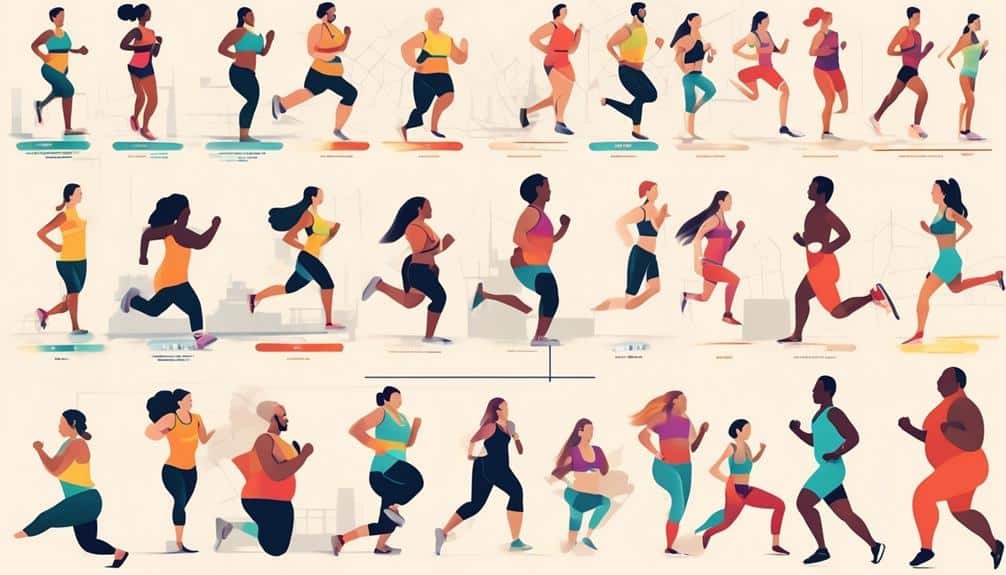As you chase the White Rabbit down the data rabbit hole, you’ll find the accuracy of fitness trackers in estimating calorie expenditure to be a curiouser and curiouser subject.
These devices promise to offer a window into your daily energy use, yet the precision of such measurements is a matter of considerable debate. You strap on your fitness tracker in the hopes of quantifying the unseen results of every step taken, every stair climbed, and every calorie burned. But how much can you trust these digital companions?
Recent research suggests that there may be a significant gap between what’s recorded on your wrist and what’s actually happening in your body. As you consider adjusting your diet or exercise plan based on these metrics, it’s crucial to understand the variables and potential inaccuracies at play.
Will you find that your trusty gadget is a reliable ally on your fitness journey, or could it be leading you down a path paved with questionable data? The answer lies in a deeper exploration of the science and technology behind these popular devices.
Key Takeaways
- Fitness trackers use complex algorithms to estimate calorie expenditure based on factors such as age, weight, height, and activity level.
- The accuracy of calorie tracking can be challenging, and studies have shown that calorie expenditure data may be inaccurate.
- Sensor data interpretation, including heart rate monitoring and movement sensors, is crucial for accurate calorie tracking.
- Personal body profile data and exercise type/intensity play a role in refining calorie expenditure calculations, but there are limitations in accurately tracking exercise type and intensity.
Understanding Metabolic Rate
To accurately estimate daily caloric burn, it’s crucial to consider your metabolic rate, which hinges on variables like age, weight, height, and overall activity level. Your metabolic rate isn’t static; it’s an ever-changing figure based on your body’s internal and external demands. At its core, the metabolic rate is the quantifiable narrative of your body’s energy narrative, with calories serving as the currency.
Measuring energy expenditure is a complex equation, and your basal metabolic rate (BMR) is its foundation. Accounting for the majority of calories burned, BMR represents the bare minimum your body needs to function—even when you’re binge-watching your favorite series. It’s typically gauged in the tranquility of the morning, post a good night’s sleep and a 12-hour fast, to ensure accuracy.
However, physical activity is the variable that can tip the scales. Whether you’re hitting the gym or chasing after your career ambitions, every movement counts. Activity trackers aim to capture this aspect of energy expenditure, often utilizing heart rate as a proxy for intensity. While they’re notably accurate for measuring steps, gauging overall calories burned can be trickier. That’s because heart rate and energy expenditure are interconnected, yet not perfectly aligned. Precision in tracking depends on the sophistication of the device and the algorithm’s ability to personalize to your unique metabolic fingerprint.
Algorithms Behind Calorie Tracking

You’ll find that fitness trackers use complex algorithms to turn your activity data into calorie expenditure estimates. These algorithms must accurately recognize different types of activities and interpret sensor data to provide you with meaningful insights.
As you evaluate various devices, consider how the methodology behind calorie counting and the precision of activity recognition can affect the tracker’s overall effectiveness for your fitness goals.
Calorie Counting Methodology
Delving into the algorithms fitness trackers use to quantify calorie expenditure, it’s crucial to understand that these systems integrate variables such as heart rate, motion, and personal metrics to produce energy usage estimates.
Here’s how fitness trackers count calories:
- Heart Rate Measurements: By monitoring your pulse, trackers estimate how hard your body is working.
- Motion Sensors: Accelerometers and gyroscopes measure the intensity and frequency of your activity.
- ersonal Data: Age, weight, height, and gender inform the algorithm’s baseline for measuring burned calories.
These elements underpin calorie counting methodology, aiming to provide accurate devices for energy expenditure tracking. However, precision varies, and you should be aware that even the most sophisticated algorithms face challenges in perfectly capturing the complexity of human metabolism and activity levels.
Activity Recognition Accuracy
When assessing the precision of fitness trackers, research indicates that while they reliably measure steps and heart rate, their algorithms often fall short in accurately identifying energy expenditure. You want to trust that these devices provide a sense of camaraderie in your fitness journey, but it’s crucial to understand their limitations.
The activity recognition accuracy of fitness trackers is pivotal for estimating calories burned, yet studies show this is where accuracy waivers. Despite rigorous testing by manufacturers, you’re often left in the dark regarding the true accuracy of calorie expenditure data.
Methodical analysis reveals that while steps and heart rate are measured accurately, proprietary algorithms handling energy expenditure introduce significant inaccuracies. This affects your ability to accurately monitor the calories you’ve burned, underscoring the need for improved algorithmic transparency and validation.
Sensor Data Interpretation
Fitness trackers often rely on complex algorithms to turn sensor data into calorie burn estimates, but the precision of these calculations can vary widely across different devices. Understanding how these devices measure heart rate and energy expenditure is crucial if you’re counting on them to accurately measure the effort you’re putting into your workouts.
Here’s what you should keep in mind:
- Fitness trackers measure heart rate directly using optical sensors.
- Algorithms estimate calories burned, a really complex task that considers multiple variables.
- Measuring heart rate continuously allows for a more dynamic calculation of energy expenditure.
Role of Movement Sensors
At the heart of every fitness tracker, movement sensors play a pivotal role in the precise measurement of your physical activity and step count. These wearable devices leverage sophisticated technology to track your activity, ensuring that every step you take is accounted for. When you strap on your tracking device, the integrated movement sensors—often accelerometers—begin to methodically interpret your motions.
The data-driven accuracy of these sensors directly influences how reliably fitness trackers count your steps, measure heart rate, and estimate the calories you burn. As such, the quality and precision of movement sensors are paramount. These tiny yet potent components detect the intensity and pattern of your movement, enabling the device to differentiate between a leisurely stroll and a vigorous run.
Impact of Body Profile Data

While movement sensors capture your activity with remarkable accuracy, the integration of your personal body profile data, such as skin color and BMI, further refines the precision of calorie expenditure calculations by fitness trackers.
Here’s why your device’s accuracy depends heavily on these personal details:
- Body Mass Index (BMI): Your BMI influences how much energy you expend during activities. A fitness tracker that adjusts for your specific BMI can estimate calorie burn more accurately than one that doesn’t.
- Skin Color: The optical sensors used to monitor heart rate can be affected by skin pigmentation. A device that’s measuring heart rate with consideration to skin color can provide more reliable data for calorie expenditure estimates.
- Height and Weight: These metrics are critical for calculating energy expenditure, as they determine your basal metabolic rate and the energy cost of movement.
Your fitness tracker becomes more than just a device; it’s a companion attuned to your personal story. By leveraging body profile data, it ensures the calorie count isn’t just a number, but a reflection of your unique physiological makeup.
Is your current tracker accurate enough? It’s essential to choose a device that sees you, not just your steps.
Exercise Type and Intensity Effects

Delving into the realm of exercise, it’s clear that the type and intensity of your workout significantly influence the accuracy of calorie burn calculations by your fitness tracker. High-intensity activities, in particular, can challenge your device’s ability to accurately measure energy expenditure. As you push your limits, the heart rate data, which is central to most fitness trackers’ algorithms, becomes crucial.
However, wrist-based sensors may not be as precise as a chest strap, leading to discrepancies in the reported calorie expenditure.
Your fitness tracker’s performance in estimating calorie burn also varies with different user activities. While steady-state exercises like running or cycling might be tracked more accurately because of consistent heart rate data, complex movements such as weightlifting or high-intensity interval training can result in less accurate readings. This is because these activities cause fluctuations in your heart rate that are more difficult for the tracker to interpret.
In short, exercise type and intensity effects play a pivotal role in the precision of fitness trackers. To enhance the chance of getting accurate data, consider supplementing your tracker with a chest strap during vigorous workouts, as they tend to provide a more reliable heart rate measurement, which is key to a more accurate calorie expenditure estimate.
Integrating Food Logging Features
To enhance personal health management, many fitness trackers now feature food logging capabilities, allowing you to meticulously track your daily caloric intake in relation to your expenditure. By integrating food logging features, these devices provide a holistic view of your health, encouraging a community of users who support each other in the journey towards better fitness and nutrition.
Here are some critical aspects to consider:
- Comprehensive Data Analysis: Fitness trackers use food logging to compile detailed data points on your eating habits, creating a more accurate picture of calorie intake.
- Activity-to-Intake Ratio: They calculate the balance between the calories you consume and burn, factoring in data from heart rate monitors and other sensors.
- Personalized Feedback: Using multiple inputs, these devices offer tailored advice on how to adjust your diet to meet your fitness goals.
How Accurate Are Fitness Trackers in Measuring Caloric Expenditure During Different Workouts?
When it comes to measuring caloric expenditure during different workouts, having the perfect fitness tracker companion can be essential. These devices use advanced technology to monitor heart rate, movement, and other factors to provide an estimate of calories burned. While not 100% accurate, they can be a helpful tool in tracking fitness progress.
Conclusion
In conclusion, your fitness tracker’s calorie burn estimates aren’t fully reliable. With the best models erring by 27% and the worst by 93%, it’s clear that the technology has limitations.
Your body’s unique metabolic rate, the specific algorithm’s efficacy, sensor accuracy, personal data input, exercise type, and intensity—all influence the precision of these devices.
Until advancements are made, remember these trackers are tools for approximations, not exact measures of your energy expenditure.




